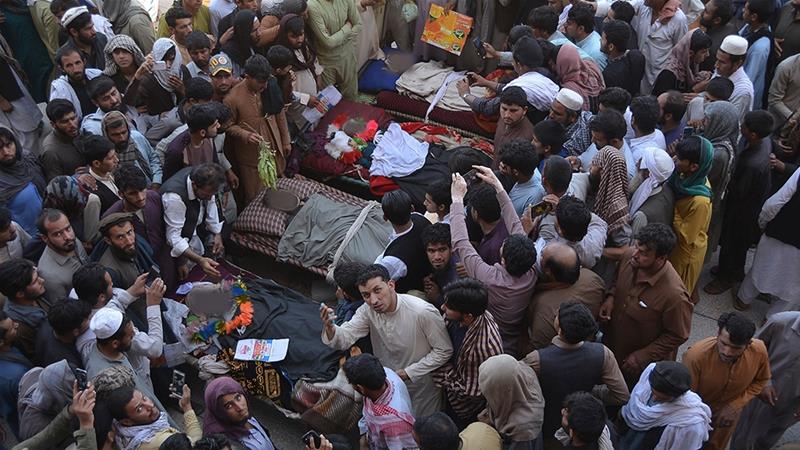CIA-backed Afghan forces possibly committing war crimes: HRW
In a damning report, Human Rights Watch says night raids and aerial strikes have led to mounting civilian casualties.
Kabul, Afghanistan – CIA-backed Afghan strike forces are once again under fire in Afghanistan, this time for tactics – night-time raids into homes in remote villages, forced disappearances, attacks on healthcare facilities and summary executions – that Human Rights Watch says amount to “atrocities” and possible “war crimes”.
In a damning 50-page report released on Thursday, the New York-based rights group documents 14 cases across nine provinces over the last two years, that they say clearly illustrate that the Afghan forces trained and funded by the US intelligence agency have shown little concern for civilian life and or accountability to international law.
More:
-
More than 350,000 Afghans displaced in 2019: UN report
-
What peace means for Afghanistan’s Hazara people
-
The Afghan ‘peace’ deal will not bring peace to the Afghan people
“In case after case, these forces have simply shot people in their custody and consigned entire communities to the terror of abusive night raids and indiscriminate airstrikes,” said Patricia Gossman, Associate Asia Director and the report’s author, after speaking to three dozen witnesses of such operations.
The report coincides with recent findings by the United Nations that so far in 2019, Afghan and international military forces have been responsible for 484 civilian deaths and 777 civilian injuries. At least 468 of those civilian deaths were attributed to foreign forces.
Adding to the worries are new figures from the Pentagon showing that US forces conducted 1,113 air raids in the month of September alone, a figure which amounts to an average of 40 air raids a day.
Night raids
For years, civilians in some of Afghanistan’s most volatile provinces have been complaining about the practice of night raids – which see Afghan and foreign forces entering rural households in the dead of night – and the over-reliance on aerial attacks, which they say continue to target civilians.
The Eastern province of Nangarhar, a three-hour drive from Kabul, has been one of the hardest hit, with residents being victim to both drone attacks and night raids that officials say were meant to target Taliban or so-called Islamic State in Iraq and the Levant (ISIL), also known as ISIS, forces. The HRW report cites three cases of both summary executions and indiscriminate air attacks in the province that led to at least 30 civilian deaths.
Massoud, a resident of Khogyani district, which has been the site of numerous aerial operations conducted by Afghan and US-led NATO forces, said the findings of the report were not surprising.
The 25-year-old said his family recently had to move to the provincial capital, Jalalabad, because the threats of attack from all three sides in the war – Afghan forces, Taliban and ISIL – was becoming unbearable.
“I was a good student, I tried to study, but I’ve seen too much death. Every day, I live in fear of the deaths of my family from the drones and planes. I cannot concentrate any more.”
He blames the increased number of deaths in Khogyani, and Nangarhar as a whole, on the over-reliance on air raids in the province.
According to the Pentagon’s own figures, there were at least 24 air attacks conducted in Nangarhar in the September. One particular source of worry is a 2017 authorisation by US Forces that allows for Afghan Special Forces to call in air strikes even in areas where there are no US ground forces to verify the target.
Massoud points to a years-long complaint about Afghan informants: “These spies, they only ever give out bad information, anyone they do not like they say they are a Talib or Daesh (another name for ISIL), this is why civilians keep dying.”
Mohammad and other Khogyani residents Al Jazeera spoke to said one of the biggest sources of their fear was the CIA-trained and funded 02 Unit of the Afghan intelligence services which has been accused of numerous civilian deaths, including the September killings of four brothers in the city of Jalalabad that caused public outrage.
All of the cases involving the 02 Unit the report investigated took place in Nangarhar.
‘Nineteen raids a night’
According to the HRW report, the first documented activities by the 02 Unit came in 2017, when the US decided the best way to inflict massive casualties on the Taliban and other armed groups was through the use of increased night raids.
Night raids have long been a controversial practice in Afghanistan. According to an Open Society Foundation report, between December 2010 and February 2011, US Special Forces, along with the Afghan military, conducted an average of 19 night raids each night.
In 2013, after complaints of human rights abuses then-President Hamid Karzai ordered US Special Forces out of the province of Wardak and eventually an end to all night raids.
However, when the National Unity Government, headed by President Ashraf Ghani came to power the following year, the ban was quickly and quietly lifted.
Massoud, the Khogyani resident, said the impact of these sorts of decisions, made in near secrecy, were rarely reported on.
“Very few reporters dare to come here, otherwise what happens in Khogyani almost never gets reported,” Massoud said on why he thinks groups like 02 Unit and the CIA-backed forces are so rarely held to account.
Emran Feroz, an Afghan Austrian journalist who has been tracking aerial operations in Afghanistan since 2011, said the impact of the abuses by groups like the 02 Unit were immediate because they often ended up driving angry civilians into the arms of the Taliban.
“When you kill 10, 20, 30 civilians in a single strike, an entire village will turn against the Americans and the government and instead run to the Taliban,” said Feroz, who previously investigated abuses by CIA-backed forces in the east province of Khost.
Source: Read Full Article



